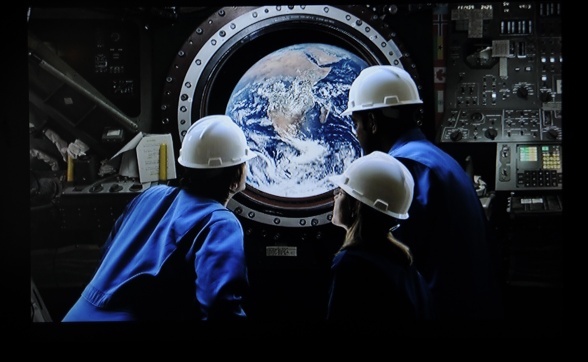Nancy Davenport

Nancy Davenport, Workers (leaving the factory) (installation view), 2008

Nancy Davenport, Workers (leaving the factory), installation view, 2008.

Nancy Davenport, Workers (leaving the factory), video still, 2008.

Nancy Davenport, Workers (leaving the factory) 2008.
Nancy Davenport, Workers (leaving the factory) (installation view), 2008
A Canadian artist living and working in New York, Nancy Davenport (b. 1965, Vancouver) constructs reality-bending images that fall somewhere between photography and moving image, stillness and high-speed, fiction and document. In 2004, Davenport began Workers (leaving the factory) an evolving series of projects that transforms itself for each exhibition context. Growing out of the artists's enduring interest in the shifting relations between individuals and institutions, workers reflects on the historical representation of labour and the complex social transformations of contemporary industry.
For MADE UP, a new sequence of Workers was commissioned and shot at the Jaguar car plant in Halewood, Merseyside. Against the background of Ford’s sale of Jaguar to Indian Conglomerate Tata, the piece focused on the manufacture of a red X-Type car, which Davenport followed through a hypnotic assembly line. The artist combined digital photography and video to track the elegantly efficient process, from inception to test run. She also documented a parallel journey: the drive to work of one of the factory workers, captured from a surveillance camera mounted on the bumper of his car.
The new sequence was inspired by two cult car films of the 1970s: British Sounds (Jean-Luc Godard and Jean-Henri Roger) and C'etait un rendezvous (Claude Lelouch). Designed as a political artefact, Godard’s film was commissioned and later banned by BBC Weekend Television in 1969 and is famous for its ten minute tracking shot of an MG assembly line. Lelouch’s piece has been described as ‘one of the most irresponsible films ever made’ and features a frantic eight-minute drive through the streets of Paris shot in a single take at a top speed of 200 km/h. Davenport reconfigured elements of these two polemical films (the allure of the machine and the need for new forms of political resistance), while referring to labour relations and the pull of offshore trade.
Within an utterly contemporary framework, Davenport developed and pieced together these apparently diverse plots and evoked a scenario where all events, both human and robotic, became related and cyclical. In previous sequences of Workers, presented as a multi-channel installation, Davenport referenced two of the first films ever projected before an audience: Workers Leaving the Lumiere Factory (1894) and Journey to the Moon (1902) by George Melies.
A century after Lumiere’s film it can be said that factories have little allure for the camera. Hinting at the poetic linkage of fantasy and documentary style in the early days of cinema, Davenport’s piece recreated the movement of the employees of a global corporation through both realistic and imaginary spaces – a factory, a virtual lounge and a spaceship venturing into outer space. Also on show was a special edition of preview posters, with a nod to both agitprop and advertising.
The overlap of narratives and sources throughout Workers aims to register the complexity of our present moment, the changing notions of community and locality, and the legitimacy of art as a means of social enquiry.
Nancy Davenport at Liverpool Biennial 2008
Workers (leaving the factory), 2008
Multi-channel video installation, with single channel projection and six monitors
Commissioned by Liverpool Biennial 2008
Exhibited at Open Eye Gallery
Supported by
Canada House Arts Trust
Liverpool Biennial
55 New Bird Street
Liverpool L1 0BW
- T +44 (0)151 709 7444
- info@biennial.com
Liverpool Biennial is funded by
Founding Supporter
James Moores